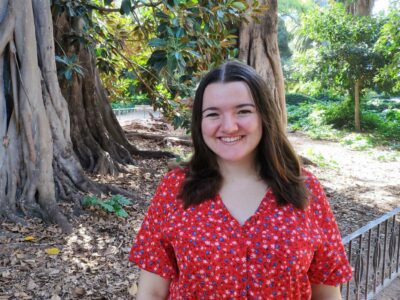
Mohammed at the site of his destroyed lab in May 2021. It was bombed in an Israeli strike, destroying with it his years of patient work in medical innovations. Photo provided by Mohammed, used with permission.
I met Mohammad in 2018 while interning at a digital fabrication lab in Amman, Jordan. It was late afternoon, and the lab was almost deserted. Two men were playfully experimenting with the laser cutter, trying to figure out how it worked while sharing a moment of fun.
Intrigued, I approached them to see if they needed any help figuring it out. They seemed to have navigated their way around the tool, so we started chatting.
I couldn't help but stare at an orange plastic object in front of them. It had a central Y-shaped component with a transparent, flexible tube hanging from its tail, and a circular plastic piece attached to it. They handed me two rubber earbuds to fix on each end of the Y-shaped piece: it was a stethoscope, with some parts 3D-printed, and others bought and assembled.
Mohammad and his friend were in transit in Amman awaiting a Canadian visa. Their team was invited to attend a conference to showcase their work on manufacturing open-source medical hardware in Gaza. Unfortunately, they were denied a visa to Canada, and so they returned home.
The blockade of medical supplies in Gaza
“Why not just buy stethoscopes?” I asked. Mohammed explained that first of all, bringing stethoscopes into Gaza was often impossible because the Israeli occupation arbitrary restricts entry of aid claiming they are dual-use goods. Second, buying stethoscopes in large quantities wasn’t feasible as they are expensive.
For emphasis, the Israeli occupation bans many essential and life-saving medical equipment under the dual-use goods claim. These restrictions began with the land-air-sea blockade on Gaza in 2007.
The entry of every atom into Gaza is managed through the Coordinator of Government Activities in the Territories (COGAT), a unit within the Israeli Ministry of Defence that “implements civilian policy” within the remaining Palestinian territories.
Mohammad and his team needed to find a way to circumvent the blockade, so they turned to local manufacturing, focusing on open-source 3D printing.

The array of 3D printers that Mohammed created with his team. Photo provided by Mohammed, used with permission
By no means coincidentally, 3D printers are also on the list of items prohibited from entering Gaza. Since he could not simply ship printers in, Mohammad started working out which parts were needed to assemble a printer from scratch. He collaborated with a colleague based outside Gaza who could bring in small printer parts when travelling into Gaza. Mohammad would then purchase TV sets, disassemble them, and extract chips to repurpose for the printer.

Mohammed mixing plastic for his 3D printer. Photo provided by Mohammed, used with permission.
With the first machine nearly complete, Mohammad needed plastic filament, which makes up 3D printing ink. He purchased small plastic pellets from a local factory, melting and converting them into smooth 3-millimetre filament using yet another homemade machine.
Mohammed used one printer to print other 3D printers until he had a grid of machines working in concert. Using this network, his team succeeded in printing a $3 stethoscope, which performed almost equally to a $200 instrument. They printed thousands and distributed them across hospitals in Gaza.
Creative solutions to address complicated medical problems
Mohammed soon realized that printing stethoscopes alone was not sufficient to address the scale of violence Gazans faced from the Israeli occupation.
He would study the occupation army’s strategies carefully, focusing on the wounds they inflicted. He noted that the Israeli occupation would often aim and shoot at limbs instead of direct headshots. He reasoned that their goal was to let someone bleed out slowly and suffer before they took their last breath.
When medical emergency responders could get to patients, they would use regular bandages to wrap around the wounded area, and tighten it as much as they could to try to stop the blood from draining out. However, these weren’t effective.

The plastic tourniquet Mohammed and his team created to stop bleeding that is caused by Israeli bullet injuries. Photo provided by Mohammed, used with permission.
Mohammad and his team designed a plastic tourniquet attached to a thick belt. The plastic piece was used to lock the belt in place. They printed as many as they could with the limited material they had and spread them inside Gaza's ambulances.
At a workshop in Amman in 2018, Mohammad shared that one day, the Israeli occupation targeted a family of four. When the ambulance arrived, they had only two plastic tourniquets on hand. Despite treating all four family members, only the two who were given the 3D-printed tourniquets survived. He paused and pondered: “I didn’t know whether to feel happy or sad. Happy because the pieces we printed saved two souls, but sad because we just couldn’t print enough.”
Escalating risks, and seeking refuge
Over the days, months, and years, Mohammad and I would sit and talk in person when we could and over the phone when he could not leave Gaza. He would share more about his life in Gaza, his reflections about his work, and what it was contributing towards.
One year before October 7, Mohammad called me to share two new projects he was eager to launch. One was to 3D print custom-fitted back braces for patients with spinal problems, and the other was to reintroduce the manufacturing of medical gauze in Gaza.
In our conversation, he shared an intriguing tidbit: some linguists believe that the word “gauze” may have originated from the name “Gaza.” This revelation struck a chord with Mohammed, as he had connected with the descendants of Gaza's first gauze factory. He felt his projects were a way to preserve Gaza’s heritage of medical ingenuity, which could contribute towards resisting the blockade.
Today, there is no functional medical infrastructure to speak of in Gaza. The Israeli occupation has targeted hospitals, ambulances, and roads in its genocidal campaign on Gaza, devastating the healthcare system.
And just a couple of weeks ago, Mohammad wrote to me that one of his friends was killed by an Israeli airstrike on his home:
We had last met 4 days ago. We celebrated our 20th anniversary of friendship. We talked about the situation, how we could adapt. We envisioned the future of our conflict with the occupier. My friend, having recently repaired his home and resettled, focused on fixing electrical devices and solar cells, despite knowing that this work was dangerous because such skill made him a target. He imparted the harsh reality that we must reconcile with the circumstances, as we don't have the luxury of choice.
Since the onset of the genocide, Mohammad has rejected the idea of leaving Gaza. His parents are refugees from the Nakba of 1948 when the Israeli occupation forced them to leave their village of Ni'ilya, which is now part of the city of Ashkelon (just north of Gaza). Mohammed refused to become a refugee again, a generation later, at the hands of the same settler-colonial entity. He told me last October: “I only have one wish, that my father will live until the day of Palestine’s liberation.”
Six months later, the risks to Mohammad’s life are too high, as Israel is targeting people with skills, such as journalists, doctors, and most recently, engineers and information technology experts. He can no longer ensure his family’s safety. He finally decided to leave Gaza with his wife and four children in the hopes of saving them and then coming back to serve Gaza and Palestine.
“Because of Us”
This morning I learned
The English word gauze
(finely woven medical cloth)
Comes from the Arabic word غزة Ghazza
Because Gazans have been skilled weavers for centuriesI wondered then
how many of our wounds
have been dressed
because of themand how many of theirs
have been left open
because of us.







